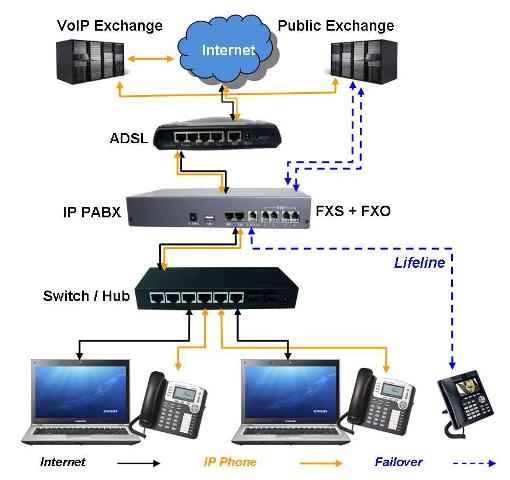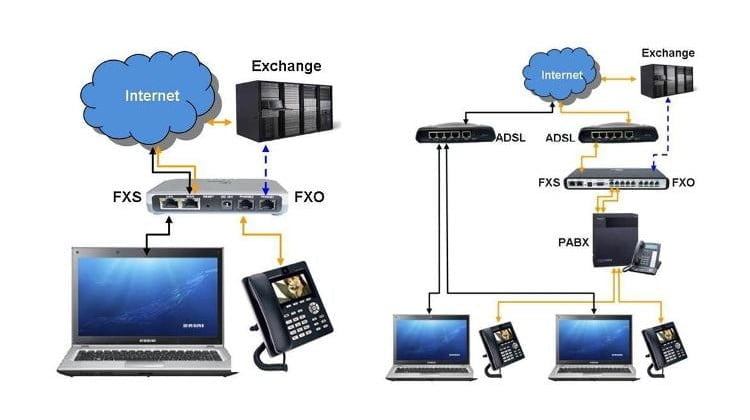See Common Telecommunication and VoIP Terminology for an explanation of technical terms if necessary.
THE ORIGIN OF VOICE OVER INTERNET PROTOCOL
A major development that started in 2004 was the introduction of mass-market VoIP services that utilise existing broadband Internet access, by which subscribers place and receive telephone calls in much the same manner as they would via the Public Switched Telephone Network. Full-service VoIP phone companies provide inbound and outbound services with Direct Inbound Dialling. Some offer unlimited domestic calling for a flat monthly subscription fee. This sometimes includes international calls to certain countries. Phone calls between subscribers of the same provider are usually free in some countries when a flat-fee service is not available, resulting in massive savings in monthly call charges, especially when branch offices of a company or customers and suppliers share the same VoIP provider.
WHAT IS VOICE OVER INTERNET PROTOCOL?
Voice over Internet Protocol (VoIP) is a family of technologies and transmission techniques for the delivery of voice communications and multimedia sessions over the Internet. Other terms frequently encountered and often used synonymously with VoIP are IP Telephony, Internet Telephony, Voice over Broadband, Broadband Telephony and Broadband Phone.
Depending on the Coding and Decoding (codec) used for voice transmission over broadband Internet, each VoIP telephone line requires at least 24 kb/s sustained Internet bandwidth (12 kb/s upload and 12 kb/s download) to maintain a good voice quality comparable to phone calls via Public Switched Telephone Networks. Normally such a low data transfer rate is easy to maintain, except when the same line is used for Internet browsing or when Internet access is gained via wireless GSM networks with varying signal strength and IP Packet bursts.

HOW DOES VOICE OVER INTERNET PROTOCOL WORK?
Internet Telephony refers to voice, fax, SMS or voice-messaging services that are transported via the Internet, rather than the Public Switched Telephone Network (PSTN). The steps involved in originating a VoIP telephone call are signalling and media channel setup, digitisation of the analogue voice signal, encoding and transmission as Internet Protocol (IP) packets over a packet-switched network.
On the receiving side, similar steps (usually in the reverse order) such as reception of the IP packets, decoding of the packets and digital-to-analogue conversion reproduce the original voice stream. Even though IP Telephony and VoIP are terms that are used interchangeably, they are actually different; IP telephony has to do with digital telephony systems that use IP protocols for voice communication while VoIP is actually a subset of IP Telephony. VoIP is technology used by IP telephony as a means of transporting phone calls.
VoIP systems employ session control protocols to control the set-up and tear-down of calls as well as audio codecs which encode speech allowing transmission over an IP network as digital audio. The codec used is varied between different implementations of VoIP (and often a range of codecs are used); some implementations rely on narrowband and compressed speech, while others support high fidelity stereo codecs.
There are three types of VoIP tools that are commonly used; Software VoIP, IP Phones and Mobile Integrated VoIP.

WHAT IS REQUIRED FOR VOICE OVER INTERNET PROTOCOL?
Broadband Internet Access: Reliable Internet access is an obvious basic requirement. Broadband Internet access with a 24 kb/s sustained bandwidth is required per each VoIP exchange line. A Synchronous Digital Subscriber Line (SDSL) with equal up and download speeds may look like a great option; however the rental cost is often prohibitive while wireless broadband GSM services may fluctuate in signal strength and available bandwidth during peak demand periods. Therefore a dedicated VoIP Asynchronous Digital Subscriber Line (ADSL) line is recommended for commercial use of up to four external VoIP exchange lines in South Africa during 2011. Small or home offices with one or two computers can probably share the same ADSL line for Internet browsing; however separate Internet access facilities for browsing and VoIP is strongly recommended. A 4GB capped ADSL facility is roughly capable of handling up to four VoIP exchange lines with a combined talk time of around 46.3 hours per month. Large Call Centres may require a leased Diginet line for Internet access.
Reliable VoIP Provider: Service reliability can differ substantially from one VoIP provider to the next. Similar to Cellular Service Providers, a reliable VoIP provider with excellent support and backup services is recommended. Although the prices of VoIP services may be important, the quality of services and support is just as important if not more. It is advisable to select a VoIP provider carefully by requesting references from existing customers and to avoid entering into lengthy contracts with fixed monthly expenses.
VoIP Hardware: Any standard telephone or Private Branch Exchange (PBX) can be used on an Analogue IP FXS Gateway to connect via ADSL to a VoIP exchange on the Internet. Available Foreign Exchange Stations (FXS) offer 1, 2, 4, 8 and 24 external lines to VoIP exchanges; however it is advisable to retain at least one failover or backup landline. A landline or Foreign Exchange Office (FXO) line to a Public Switching Telecommunication Network (PSTN) is recommended in the event of a power or system failure. Appropriate VoIP Hardware with an Uninterruptable Power Supply (UPS) for backup power is recommended for all commercial purposes as the technologies are robust and reliable. All software alternatives are for personal use and non-critical operations only.
Software Alternatives: Small or home offices may not require specialised equipment if the same Internet access is used for browsing and VoIP services; however it implies that computers must be switched on at all times and the software must constantly run in the background. A Software VoIP Phone like the 3CX Phone can be installed on computers. Software VoIP Phones are also available for some cellphones; however VoIP services via cellular GSM networks will remain experimental until the sustained availability of bandwidth via cellular networks improves. A further disadvantage of Internet access via GSM networks is that signal strength may vary when moving around and that a reconnection to the Internet is required when switching from one tower to the next. As mentioned, all software alternatives are for personal use and non-critical operations only. Appropriate VoIP Hardware is recommended for commercial purposes.



